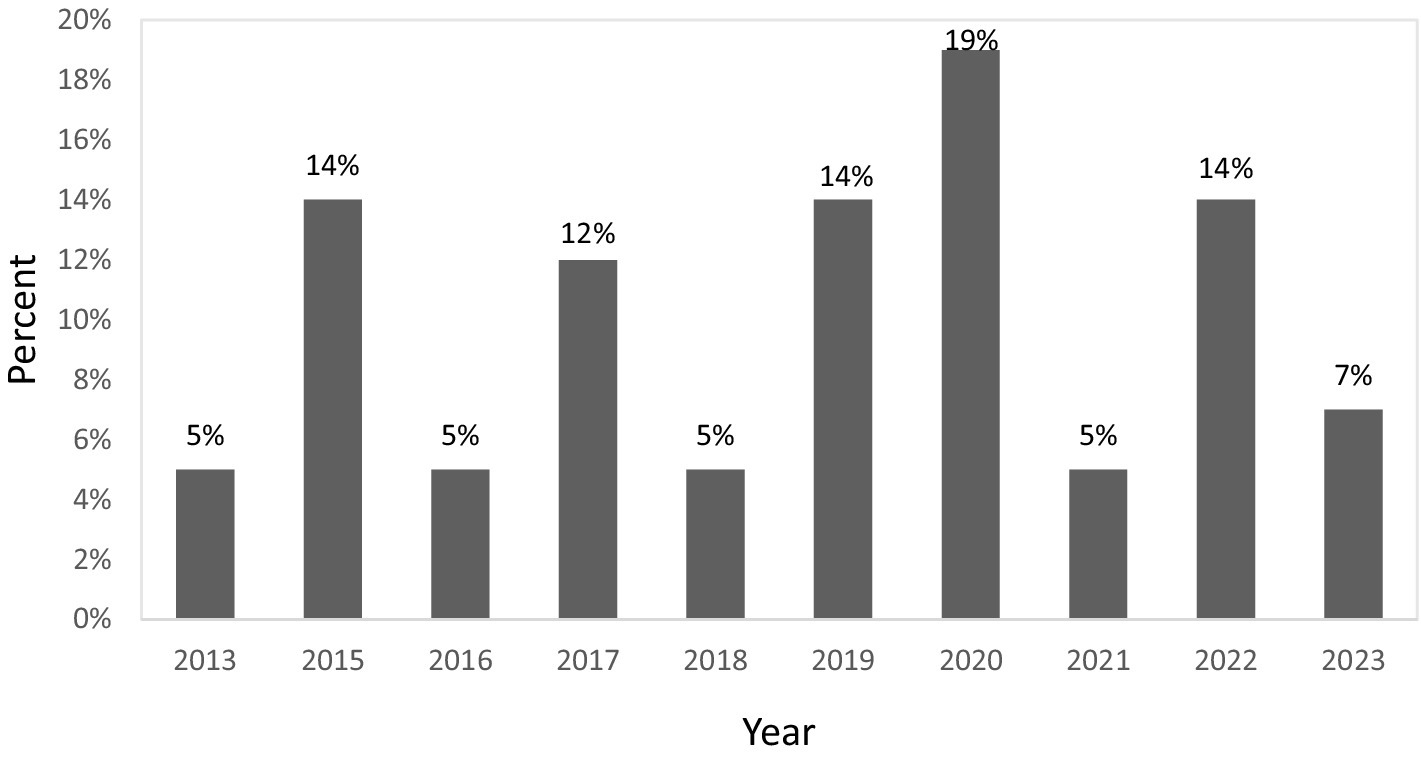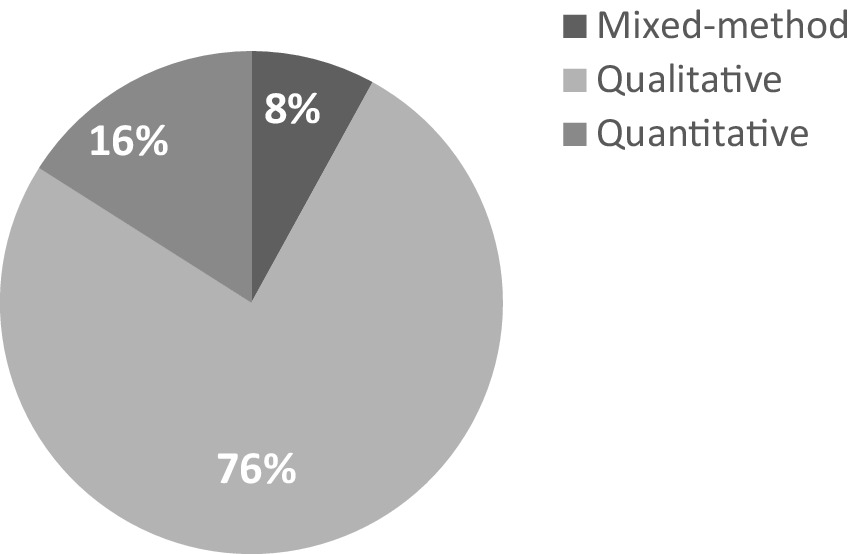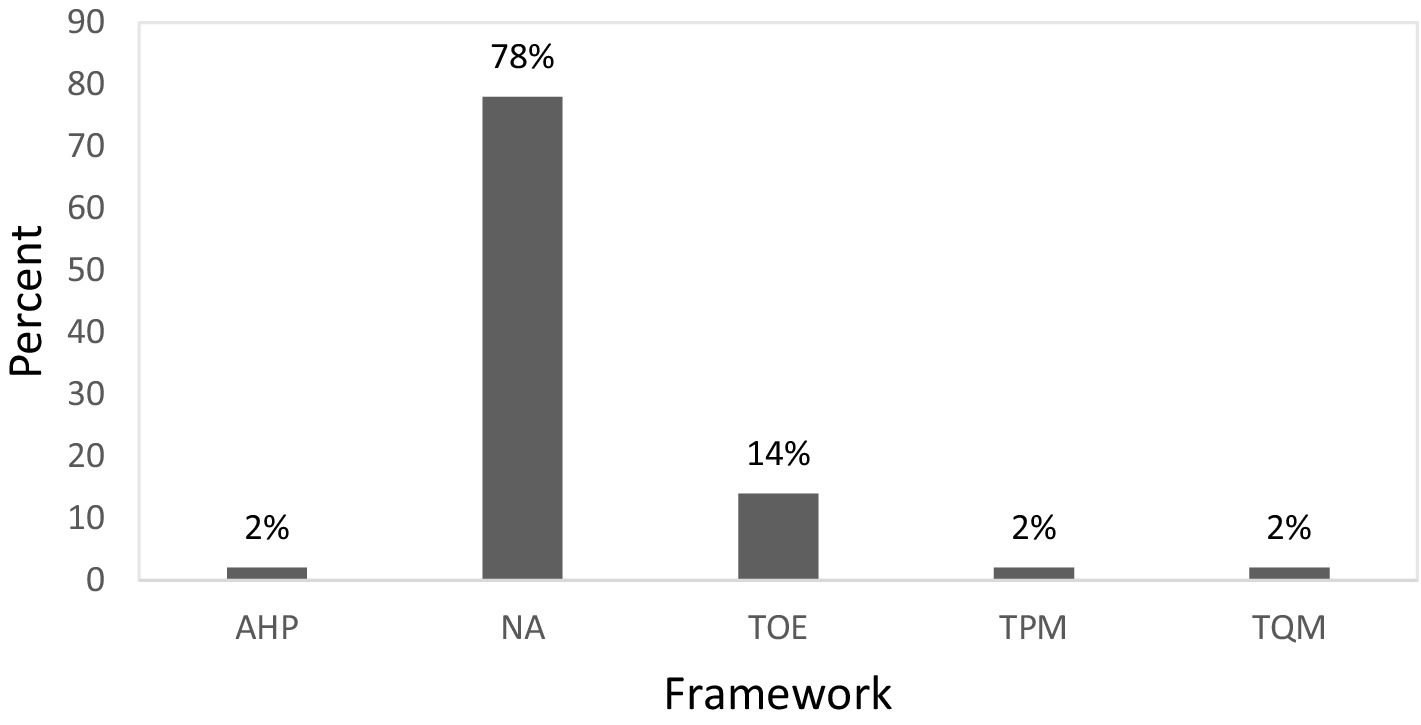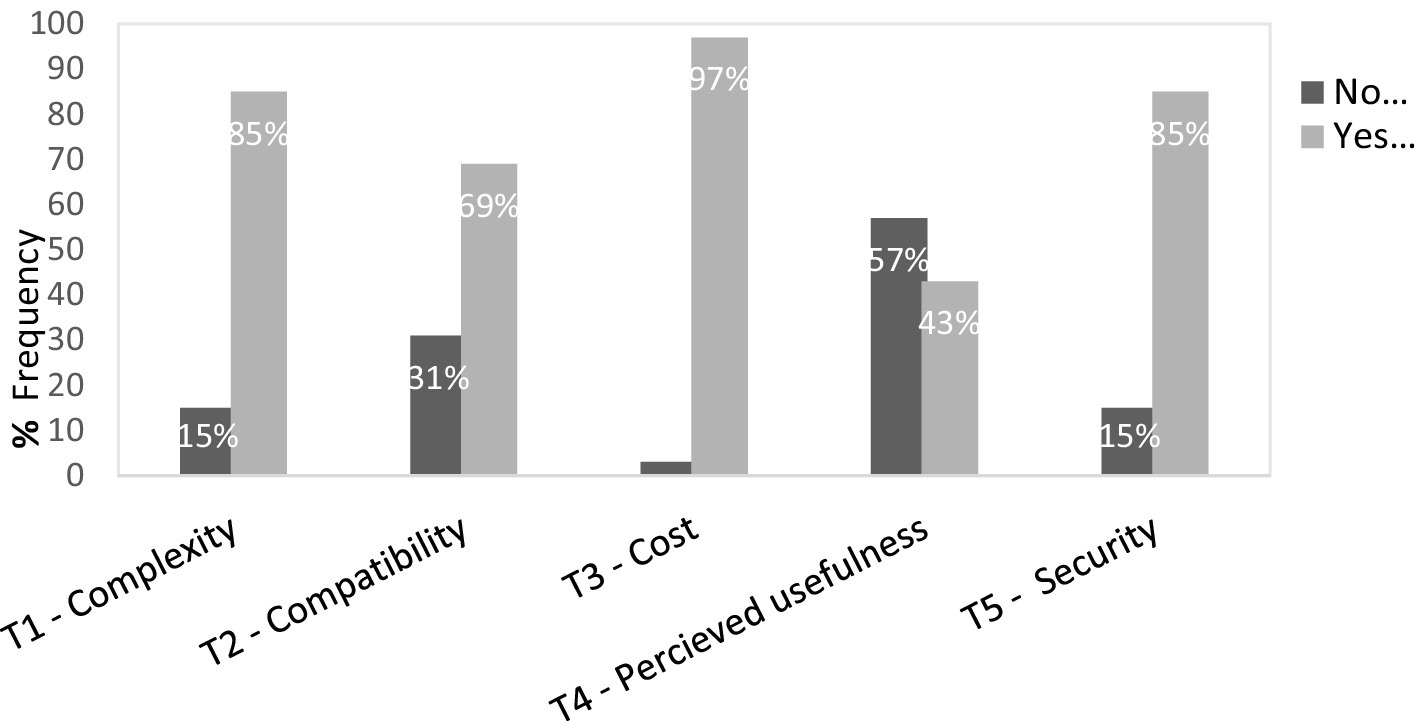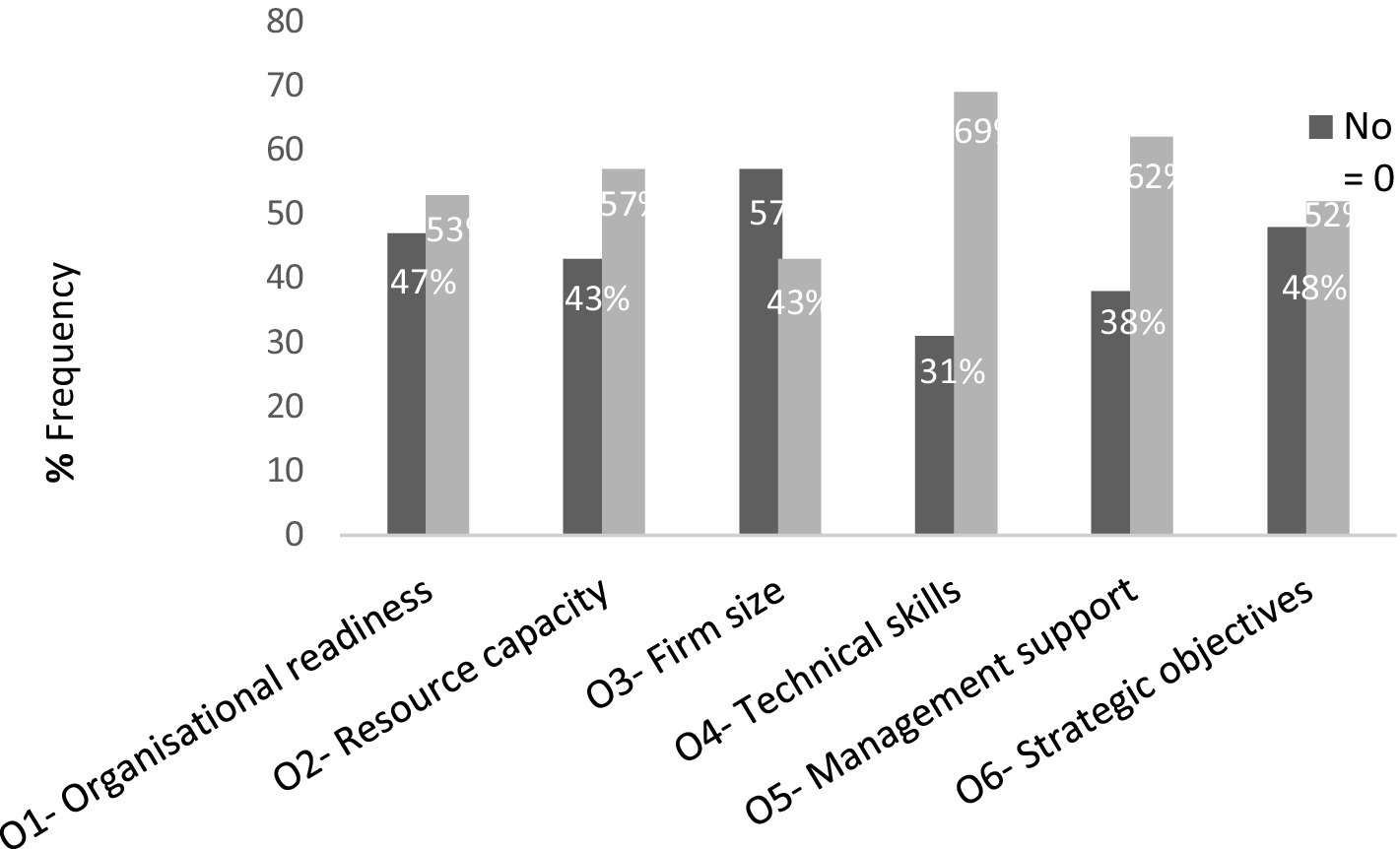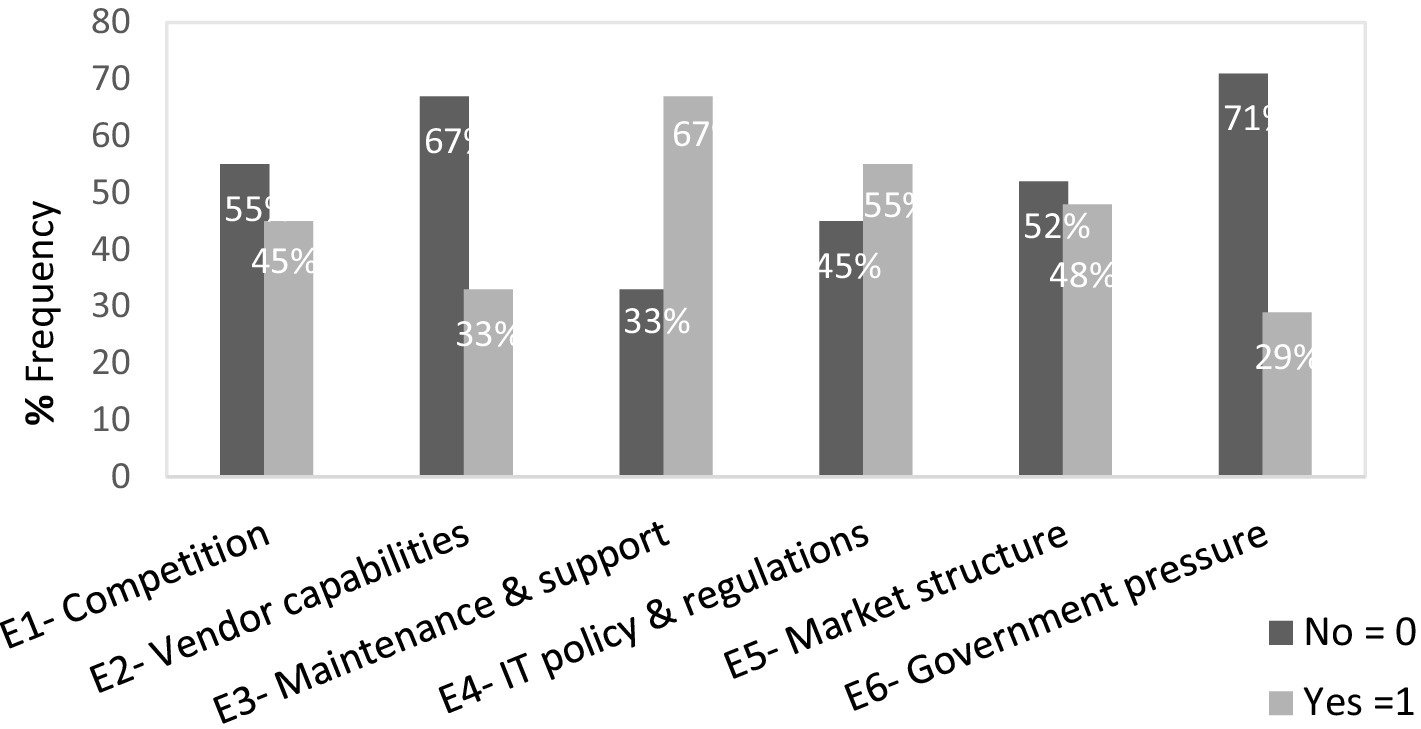- Department of Information Systems, University of the Western Cape, Bellville, South Africa
The unsustainability of the current food system raises food security concerns worldwide due to the population’s increased demand for fresh food and food safety. Unsafe food incidents lead to a high risk of poverty and economic loss. This includes food waste, safety, and security during the sustainable food system process from farm production to consumer. There is a need to implement a fast traceability system like Radio Frequency Identification (RFID) in the sustainable food system to ensure food quality and safety, meet customer demands, and achieve Sustainable Development Goals (SDGs): 1—No poverty, 2—Zero hunger and 13—Climate action for 2030 target. The study objective was to explore the factors that affect the adoption of Radio Frequency Identification (RFID) in the food supply chain. The study adopted the TOE (technology-organization-environment) framework to explore factors that affect RFID adoption in the food supply chain. The study utilized a systematic literature review to examine the TOE factors influencing the adoption of RFID in the food supply chain. The results indicate that technological (complexity, cost, and security), organizational (technical skill and management support), and environmental (maintenance and support, IT policies and regulations) are the major factors that affect the adoption of RFID in the sustainable food system industry. The study recommends organisations intending to adopt RFID allocate enough resources and be prepared to overcome RFID adoption external challenges. The study concludes that technological factors, organizational factors, and environmental factors are important factors for RFID adoption in the food supply chain. However, further empirical studies are necessary to overcome the challenges of systematic literature review based on secondary data and convenience sampling.
1 Introduction
Food is essential for life and fundamental to survival, making food security crucial for ensuring that everyone has consistent, physical, social, and economic access to sufficient and nutritious food (de Oliveira Veras et al., 2021). However, many people lack access to food due to factors such as low income, rising prices, disasters, and an unsustainable food supply chain, with approximately 70% of the global population suffering from hunger due to conflict and violence (Otekunrin, 2024). Food waste and safety are also growing concerns worldwide (Shah, 2023). The COVID-19 pandemic exacerbated food insecurity, with an estimated 720 to 811 million people facing hunger in 2020 (Bessachi and Announ, 2023). The pandemic significantly impacted the sustainable food system, leading to increased food demands, distribution challenges, and a 12% rise in food waste and traceability issues (FAO, 2021). Additionally, COVID-19 accelerated digital innovation as organizations sought novel solutions. As noted by Amusan and Oyewole (2022), food security has become a top priority globally, with the United Nations Food and Agriculture Organization (FAO) reporting a rise in the number of people experiencing hunger to 925 million.
The challenges of food imports and distribution are expected to persist as long as developing countries struggle to produce their food. Enhancing food security is a key Sustainable Development Goal (SDG) aimed at reducing the risk of malnutrition (“safe food for everyone”: FAO, 2021). In 2015, the United Nations established 17 SDGs to promote planetary and human sustainability, with a target deadline of 2030 (Sorooshian, 2024). These goals include combating poverty and malnutrition (SDG-1: No Poverty), achieving zero hunger (SDG-2: Zero Hunger), and addressing climate change (SDG-13). Ensuring safe food security can help reduce food waste and mitigate global health issues (Garcia et al., 2020).
1.1 RFID in the food system
Given the rising population and increasing demand for safe and fresh food, achieving the end-hunger targets of the Sustainable Development Goals (SDGs) by 2030 may be challenging unless more immediate and effective actions are taken to advance food security and meet zero hunger objectives (FAO, 2021). Traditional food systems are struggling to keep pace with evolving environmental demands for optimization, making digital technologies a potential solution to enhance the sustainability of food systems (Colicchia et al., 2022). Smart sensors, a key component of Food Processing 4.0 technology, play a crucial role in data acquisition, automation, and quality control (Jambrak et al., 2021). Radio Frequency Identification (RFID) has already contributed to improvements and digitalization in sustainable food systems by enhancing food quality assurance and supply chain traceability.
RFID technology, which replaces traditional barcodes, uses small device tags with wireless microchips to track food items during transportation and storage, thus improving traceability and business innovations (Wen et al., 2020). Although RFID has been around for decades, it remains a contentious innovation in sustainable food systems, with 73.68% of review papers addressing its role in food quality and safety (Kineber et al., 2023). Despite its potential, challenges related to RFID adoption persist, with only 57% of the food industry successfully implementing the technology (Zhang et al., 2022). A sustainable food system is essential to addressing food insecurity in alignment with the United Nations Sustainable Development Goals (SDGs; Djekic et al., 2021). Despite the availability of technological solutions, the adoption rate of Radio Frequency Identification (RFID) technology in the food supply chain remains low, with organizations facing various challenges and barriers to implementing RFID (Agarwal and Ankolikar, 2022). The study explores factors affecting the adoption of RFID technology in sustainable food systems using the Technology-Organization-Environment (TOE) framework to review relevant literature and analyze the findings.
1.2 Sustainable food system
A Sustainable food system refers to all food processes from farm production to consumer this includes production, handling and storage, processing and packaging, transportation, and consumption. Recently, there has been a surge in customer demand for both high-food product quality and real-time visibility of their products (Chanchaichujit et al., 2020). There has been concern about food insecurity and food waste. Joubert and Jokonya (2021) mentioned that the unsustainability of the sustainable food system is the major reason for food waste and quality standards. Food companies must implement traceability systems due to the high incidence rate of food-related issues, which leads to economic losses and impacts market value (Sezer et al., 2022). According to Tan and Sidhu (2022) organizations in the retail industry continue to face several challenges with RFID adoption.
The 4th Industrial Revolution (4IR) has driven rapid digital transformation across various industries, shifting the focus toward customer perspectives and enhancing human life. It introduces the Food 4.0 processing concept which automates food processes in the sustainable food system industry to improve food security sustainable development goals (SDGs), reduce waste and cost, save time, save energy and resources, and improve the quality and safety of food products (Hassoun et al., 2023). The sustainable food system sector uses smart sensors like Radio Frequency Identification (RFID) technologies to trace food items, capture data, and improve the transparency between partners during food product movement.
Agarwal and Ankolikar (2022) define Radio Frequency Identification (RFID) as a wireless smart device that transmits information via radio waves. RFID technology adoption in the food supply chain can enhance business efficiency, daily productivity, and customer experience. However, its implementation in sustainable food systems remains limited (Zhang et al., 2022). This study investigates the barriers to adopting RFID technology in sustainable food systems, focusing on technological, organizational, and environmental factors. The study reviewed existing studies on factors affecting RFID technology adoption in sustainable food systems using the Technology-Organization-Environment (TOE) framework.
1.3 Previous studies
Several studies have been conducted on RFID technology’s benefits in sustainable food systems (Bhattacharya and Wamba, 2015). Rahaman and Batcha (2023) noted that RFID technology is considered the best new solution in sustainable food systems due to the GPS installations and ability to monitor the temperature compared to the traditional barcode system. They added that RFID technology is expected to grow fast in the future as many organizations consider adopting it. Existing studies conducted in developed countries show that RFID still has a great opportunity in the market, in the sustainable food system, and better performance in terms of productivity.
1.4 Technological environmental and organisational theoretical framework
In the digital age, technological innovation is often seen as a quick solution for integrating sustainability principles into business decision-making. The Technology-Organization-Environment (TOE) framework focuses on various aspects: for the technological component, it examines RFID implementation, flexibility, ease of use, data security, and the overall success or failure of RFID adoption in the food supply chain (Tornatzky and Fleischer, 1990). Aparnna (2022) highlights that while Industry 4.0 emphasizes automation and data exchange through advanced sensors, the food industry still faces challenges with adopting these technologies, as the pace of technological integration is slower than anticipated.
The need for technology experts for implementation and maintenance remains a significant hurdle. Organizational factors such as culture, size, management support, technical skills, and readiness also play a role in innovation (Gertze and Jokonya, 2020; Bhattacharya and Wamba, 2015). According to Agarwal and Ankolikar (2022), cost is a major barrier to RFID adoption; although individual RFID tags are inexpensive, the cumulative cost for large quantities of products can be high. Additionally, network-related costs for data sharing, system setup, maintenance, and the lack of technical standards and normalization further complicate RFID adoption in the retail sector (Sasi et al., 2023). Environmental factors influencing RFID adoption in the food supply chain include the organization’s willingness to adopt, competitive pressures, IT policies, and customer considerations (Tornatzky and Fleischer, 1990; Rafique et al., 2022).
2 Methods
Research design refers to a structured plan outlining how data will be collected, analyzed, and measured to address research questions and objectives (Cooper and Schindler, 2014). The study employs a systematic literature review as its research design. The systematic literature review was preferred over empirical research because it allowed the synthesis of existing knowledge on RFID adoption in the food supply chain. In addition, it helped to address research gaps by identifying key factors influencing RFID adoption in the food supply chain. As a non-empirical and exploratory study, it aims to tackle the problem by synthesizing findings from relevant articles (Mouton, 2001). The study focused on peer-reviewed articles published from 2013 to 2023 to understand factors influencing RFID adoption in the food supply chain. The selection criteria for the articles were peer-reviewed and published within the 10 years from 2013 to 2023, with a focus on RFID adoption in the food supply chain. There was no exclusion about which region the article was published. The study explored factors influencing RFID adoption in the sustainable food supply chain which is important to supply chain stakeholders interested in adopting RFID technology.
2.1 Design of the Research Instrument
The study adopted a systematic literature review to identify relevant published articles on the factors affecting the adoption of Radio Frequency Identification (RFID) in the food supply chain. Keywords such as “Food Supply Chain,” “Radio Frequency Identification (RFID),” “Food Security,” “Technology Factors,” and “TOE Framework” were used to locate relevant published articles. The review focused on literature from 2013 to 2023. The study was guided by TOE framework technological factors (e.g., complexity, cost, compatibility, perceived usefulness, and security), organizational factors (e.g., readiness, resources, firm size, technical skills, management support, and strategic objectives), and environmental factors (e.g., competition, vendor capabilities, maintenance and support, IT policies, marketing, and government pressure; Morawiec and Sołtysik-Piorunkiewicz, 2023). The framework constructs guided the study in exploring the factors affecting RFID adoption in the food supply chain.
The study converted qualitative data to quantitative data in a systematic literature review (SLR), using quantitative content analysis, which involved systematically categorizing and quantifying the occurrence of factors in the reviewed articles. The conversion allowed the study to present clear, numerically represented findings that were analysed statistically. The qualitative phase reviewed the articles and identified factors that are associated with RFID adoption in the food supply chain based on the TOE framework. The factors were textual descriptions which were coded based on whether the articles mentioned these variables or not. The study created a coding scheme to classify the articles based on the presence or absence of each factor. The coding scheme was used to convert the qualitative content of the articles into quantitative data. If an article mentions a factor (e.g., Cost), assign a value of 1 (present). If an article does not mention a factor (e.g., Cost), assign a value of 0 (absent) (Table 1).

Table 1. Technology-organizational-environmental factors affecting RFI adoption in food chain supply.
2.2 Data sources, sampling strategies, and techniques
Etikan (2016) defines data sampling as the process of selecting data that meets specific research criteria. The study conducted literature searches in electronic databases such as Scopus, Web of Science, IEEE Xplore, Google Scholar, Taylor & Francis Online, Elsevier, ResearchGate, JSTOR, and Science Direct for relevant literature on the factors influencing RFID adoption in the food supply chain. The focus was on using consistent search terms while expanding the search scope. The results were then filtered and refined to extract only those articles most relevant to the research problem.
2.3 Data collection techniques (research methods)
A systematic literature review involves examining and synthesizing existing literature to test hypotheses and develop new theories (Xiao and Watson, 2017). To address the research problem concerning the factors affecting the adoption of Radio Frequency Identification (RFID), this method was employed to formulate the problem statement, incorporating Sustainable Development Goals (SDGs) 1, 2, and 13. The review process involved identifying and selecting relevant literature, including review articles, journals, and research papers, to explore the factors affecting RFID adoption in the food supply chain.
2.4 Data analysis
The systematic literature review followed a structured process of data extraction, coding, and synthesis, using the TOE framework to categorize and analyze the factors affecting RFID adoption in the food supply chain. The process categorized the findings into technological, organizational, and environmental factors, that influence RFID adoption in the food supply chain. The data analysis for the study was quantitative, involving the examination of qualitative data patterns across multiple articles. The qualitative collected data was analysed quantitatively after coding based on the TOE framework factors affecting RFID adoption. The Excel software was used to capture the qualitative coded data. After capturing data from Excel was imported into the statistical package. The SPSS statistical package was used to analyse the coded data to produce statistical results. This study’s data analysis included interpreting findings from previous research, synthesizing and analysing results through the Technology-Organization-Environment (TOE) framework, to explore the factors affecting the adoption of Radio Frequency Identification (RFID). The coded quantitative data was analysed to identify patterns, trends, or relationships between factors. Frequency analysis helped to identify which factors are most discussed in the literature. Correlation analysis helped to identify relationships.
3 Results
This section presents the results from the data collected on the factors affecting RFID adoption in the food supply chain. The first section presents demographic frequencies, followed by TOE frequencies and lastly, the correlations results of the TOE framework constructs.
3.1 Demographic data
The following section presents demographic frequencies from the data collected on the factors affecting RFID adoption in the food supply chain. The selection criteria for the articles were peer-reviewed and published within the 10 years from 2013 to 2023 with a focus on RFID adoption in the food supply chain. There was no exclusion about which region the article was published. The research examined 42 peer-reviewed articles published between 2013 and 2023 from the data collected on the factors affecting RFID adoption in the food supply chain.
3.1.1 Article by year
Figure 1 presents article-by-year frequencies from the data collected on the factors affecting RFID adoption in the food supply chain. The results show that there were some increases and decreases from 2013 to 2023 with the highest number of articles published (19%) in the year 2020 before a significant decline in 2021 of 5%. The results therefore suggest there is a consistent increase and decrease in published articles over the years.
3.1.2 Article by region
This section presents the frequency of article publication by region from 2013 to 2023. The research was limited to 4 continents, Africa had 7%, America 10%, Asia 52%, Europe 24%, and the others were not mentioned. The results show that the Asia continent had 52% the highest number of published academic articles related to the RFID technology adoption in the food supply chain and Africa had 7% the lowest number of published articles. However, 8% of the articles did not indicate the region (Figure 2).
3.1.3 Articles by the method
The section presents the frequency of the research methods used in the reviewed articles related to the factors that affect the adoption of Radio Frequency Identification technology in the food supply chain. Figure 3 results indicate that qualitative research at 76% was the most research method used to conduct the research, followed by the quantitative research method at 16% and mixed-method was the least research method used with 8% frequency.
3.1.4 Article by framework
Figure 4 bar graph illustrates the frequency of the frameworks used in the selected 42 articles related to the research objectives published between the 2013 and 2023 period. The results showed only 4 types of frameworks were used. Analytical Hypothesis Process (AHP) at 2%, Technology–organization–environment framework (TOE) at 14%, Technological Product Management (TPM) at 2%, and Technology Quality Management (TQM) at 2%. The report shows that 78% of most of the related reviewed articles did not use any framework although they pointed out the factors that affect the adoption of RFID in the food supply chain.
3.2 TEO framework factors
This section presents technological, organisational, and environmental factors that affect the adoption of Radio Frequency Identification (RFID) in the food supply chain based on the data collected from peer-reviewed articles published between 2013 and 2023.
3.2.1 Technological factors
This sub-section presents the frequency results of five technological factors that affect the adoption of Radio Frequency Identification (RFID) in the food supply chain based on the data collected from peer-reviewed articles published between 2013 and 2023. Technology factors include Complexity (85%), Compatibility (69%), Cost (97%), Perceived usefulness (57%) and Security (85%). Figure 5 presents the frequency of articles mentioning these factors as barriers to RFID adoption, demonstrated by number 0 or 1, zero (the article did not mention factors), and one (the articles mention the factors). The study only focuses on the articles that mentioned TOE factors, based on the 42 reviewed articles between 2013 and 2023, the results show that cost at 97% is the biggest barrier to the implementation and adoption of RFID followed by complexity and security at 85%.
3.2.2 Organisational factors
The study explores six organizational factors that affect the adoption of RFID adoption in the food supply chain including organizational readiness (53%), resource capacity (57%), firm size (43%), technical skill (69%), management support (62%) and strategic objectives (52%). The Figure 6 graph below depicts technical skills that had a huge impact on the adoption of RFID technology in the food supply chain followed by management support.
3.2.3 Environmental factors
Figure 7 presents the frequency results of environmental factors that affect the adoption of RFID in the food supply chain, based on the peer-reviewed articles published between 2013 and 2023. Six Organizational factors include competition (45%), vendor capabilities (33%), maintenance and support (67%), IT policies and regulations (55%), Market structure (48%), and Government pressure. Maintenance and support had a higher frequency and that shows a huge impact on the implementation and adoption of technology in the food supply chain in organizations followed by IT policies and regulations.
3.3 Technology-organization-environmental factors correlations
The table below presents the correlation results between Technology-Organization-Environmental factors explored from the selected academic articles published between 2013 and 2023. The correlation results are only significant from 0.05 and 1.01 levels. The results show that the correlation between the technological factor and organizational factor is significant at 0.009 and the technological factor and environmental factor is significant at 0.039. The correlation between organizational and environmental is significant 0.003 (Table 2).
CORRELATION/VARIABLES = TTOT OTOT ETOT/PRINT = TWOTAIL SIG.
4 Discussion
The study adopted a systematic literature review to explore factors affecting the adoption of Radio Frequency Identification (RFID) technology in the food supply chain, using the Technology-Organization-Environment (TOE) framework. The study was based on data collected from peer-reviewed articles published from 2013 to 2023 on factors affecting the adoption of RFID in the food supply chain. The demographic data showed some important trends in publication frequency. There were fluctuations in publication frequency, with a notable peak in 2020 and a decline in 2021. The Asia region had the highest publications and Africa had the lowest publications. The study indicates that the qualitative research method was the most used research method of the published articles.
The study highlights cost as the most significant barrier to RFID adoption. The high initial investment and ongoing maintenance costs associated with RFID technology are major concerns for organizations, particularly small and medium-sized enterprises (SMEs). This finding aligns with previous studies (Shah, 2023), which emphasize that cost is a key challenge in technology adoption. Complexity and security concerns are also prevalent factors in RFID adoption. The technical difficulty of integrating RFID systems with existing infrastructure can discourage companies from adopting the technology (Shah, 2023). Furthermore, security concerns, such as the potential for data breaches, remain a significant challenge for organizations considering RFID adoption. Addressing these technological barriers requires companies to devise comprehensive strategies to mitigate costs, simplify the integration process, and enhance security measures.
Organizational factors, particularly technical skills and management support, were identified as important to successful RFID adoption. The availability of skilled personnel is vital for the integration and maintenance of RFID systems (Gertze and Jokonya, 2020). This finding underscores the importance of training and knowledge development within organizations. To overcome the skills gap, partnerships with external vendors and educational programs may help. Additionally, management support plays a crucial role in driving the adoption process. As Gertze and Jokonya (2020) suggest, top management’s commitment to innovation is essential for overcoming resistance and securing resources for successful implementation. Therefore, organizations must foster a culture of support for technological innovation at all levels.
Environmental factors, such as maintenance and support services and IT policies and regulations, also emerged as important influences on RFID adoption. Organizations must consider the costs associated with long-term technical support, ensuring that reliable maintenance services are available to avoid disruptions (Gertze and Jokonya, 2020). Furthermore, IT policies and regulations are critical to promoting standardization and ensuring interoperability across supply chains (Rafique et al., 2022. Agarwal and Ankolikar (2022) argue that a well-regulated environment can significantly enhance the effectiveness and widespread adoption of RFID technology. Therefore, both organizational efforts and external regulatory frameworks need to align to ensure successful RFID integration.
The correlation analysis further reveals that technological factors like cost and complexity are linked with organizational factors such as management support and technical skills. This finding suggests that organizations with higher technical capabilities are better positioned to overcome technological barriers. Additionally, environmental factors, such as market structure and government regulations, are closely related to organizational readiness and resource capacity. This indicates that external pressures can either facilitate or hinder RFID adoption, depending on an organization’s preparedness to meet those challenges. The positive correlations suggest that a holistic approach, involving technological, organizational, and environmental factors, is necessary for successful RFID adoption.
5 Conclusion
This study explored the key factors influencing the adoption of RFID technology in the food supply chain, with a focus on technological, organizational, and environmental factors. The findings indicate that cost, complexity, and security are the most prominent technological barriers, while technical skills and management support are critical organizational factors. Environmental factors, particularly maintenance and support services, as well as IT policies and regulations, also play significant roles in adoption success. The study’s findings contribute to the body of knowledge on RFID adoption in the food supply chain, offering practical insights for organizations considering implementing RFID technology.
As a recommendation, organizations should invest in cost-effective solutions and work to simplify the integration process of RFID systems. Collaborative efforts with external vendors and experts can help mitigate the technological complexity and enhance the security of RFID systems. Also, organizations should focus on developing internal technical skills through training and partnerships with technical service providers. Additionally, securing management support is essential for fostering a culture of innovation and ensuring the successful adoption of RFID technology. Governments and regulatory bodies should work towards creating policies that promote standardization and interoperability in RFID systems across the food supply chain. This will help overcome external barriers and encourage wider adoption.
Despite the study’s contribution, there are limitations worth mentioning. The study’s reliance on non-empirical data and convenience sampling limits the generalization of the findings to a broader population. Future studies should employ empirical data collection methods, such as surveys or case studies, to validate the findings and enhance the generalizability of the results. Further research could also explore the impact of regional differences on RFID adoption across different regions.
Data availability statement
The original contributions presented in the study are included in the article/supplementary material, further inquiries can be directed to the corresponding author/s.
Author contributions
OJ: Conceptualization, Investigation, Project administration, Resources, Software, Supervision, Visualization, Writing – review & editing. FM: Conceptualization, Formal analysis, Investigation, Methodology, Project administration, Validation, Visualization, Writing – original draft, Writing – review & editing.
Funding
The author(s) declare that no financial support was received for the research, authorship, and/or publication of this article.
Conflict of interest
The authors declare that the research was conducted in the absence of any commercial or financial relationships that could be construed as a potential conflict of interest.
Publisher’s note
All claims expressed in this article are solely those of the authors and do not necessarily represent those of their affiliated organizations, or those of the publisher, the editors and the reviewers. Any product that may be evaluated in this article, or claim that may be made by its manufacturer, is not guaranteed or endorsed by the publisher.
References
Agarwal, V., and Ankolikar, S. (2022). Deployment of RFID sensors in supply chain management – a review. J. Mech. Artif. Intel. Eng. 3, 47–64. doi: 10.21595/jmai.2022.22565
Amusan, L., and Oyewole, S. (2022). Precision agriculture and the prospects of space strategy for food security in Africa. Afr. J. Sci. Tech. Innov. Dev. 15, 325–336. doi: 10.1080/20421338.2022.2090224
Aparnna, V. P. (2022). Food industry 4.0 and sustainability, the agriculture magazine E-ISSN: 2583-1755 Volume-1, Issue-2, January 2022.
Bessachi, H., and Announ, F. (2023). Food insecurity in the world in sustainable agricultural development. Int. J. Econ. Perform. 6:ffhal-04183406.
Bhattacharya, M., and Wamba, S. F. (2015). A conceptual framework of RFID adoption in retail using TOE framework. Int. J. Tech. Diffus. 6, 1–32. doi: 10.4018/IJTD.2015010101
Chanchaichujit, J., Balasubramanian, S., and Charmaine, N. S. M. (2020). A systematic literature review on the benefit-drivers of RFID implementation in supply chains and its impact on organizational competitive advantage. Cogent Bus. Manag. 7:1818408.
Colicchia, C., Creazza, A., and Perotti, S. (2022). Better sustainability in the food supply chain through technology: a consumer perspective. Inter. J. logist. Res. Appl. 66:103116.
Cooper, D., and Schindler, P. (2014). Business research methods. 12th Edn. New York: McGraw-Hill Education.
de Oliveira Veras, M., Parenti, E., and Neiva, S. S. (2021). Food security: conceptual history and pillars. Zero hunger. eds. W. Leal Filho, A. M. Azul, L. Brandli, P. G. Özuyar, and T. Wall (Springer, Cham: Encyclopedia of the UN sustainable development goals).
Djekic, I., Nikolić, A., Uzunović, M., Marijke, A., Liu, A., Han, J., et al. (2021). Covid-19 pandemic effects on food safety-Multi-country survey study. Food Control 122:107800.
Etikan, I. (2016). Comparison of convenience sampling and purposive sampling. Am. J. Theor. Appl. Stat. 5:1. doi: 10.11648/j.ajtas.20160501.11
FAO (2021). Food and agriculture Organization of the United Nations. The State of Food Security and Nutrition in the World. Available at: https://www.fao.org/state-of-food-security-nutrition/2021/en/ (Accessed April 2, 2023)
Garcia, S. N., Osburn, B. I., and Jay-Russell, M. T. (2020). One health for food safety, food security, and sustainable food production. Front. Sustain. Food Syst. 4:1. doi: 10.3389/fsufs.2020.00001
Gertze, K. M., and Jokonya, O. (2020). “Factors affecting the adoption of smart Technologies for Traceability of raw materials in the retail industry.” in International Conference on Multidisciplinary Research Vol., 2020. pp. 201–213
Hassoun, A., Jagtap, S., Trollman, H., Garcia-garcia, G., Alhaj, N., Goksen, G., et al. (2023). Food processing 4.0: current and future developments spurred by the fourth industrial revolution. Food Control 145:109507. doi: 10.1016/j.foodcont.2022.109507
Jambrak, A. R., Nutrizio, M., Djekic, I., Pleslić, S., and Chemat, F. (2021). Internet of nonthermal food processing technologies (IoNTP): food industry 4.0 and sustainability. Appl. Sci. 11:686. doi: 10.3390/app11020686
Joubert, R. -L., and Jokonya, O. (2021). A systematic literature review of factors affecting the adoption of technologies in food waste management. Comput. Sci. 181, 1034–1040.
Kineber, A. F., Oke, A. E., Elseknidy, M. H., Hamed, M. M., and Kayode, S. F. (2023). Barriers to the implementation of radio frequency identification (RFID) for sustainable building in a developing economy. Sustain. For. 15:825. doi: 10.3390/su15010825
Morawiec, P., and Sołtysik-Piorunkiewicz, A. (2023). ERP system development for business agility in industry 4.0—a literature review based on the TOE framework. Sustain. For. 15:4646. doi: 10.3390/su15054646
Mouton, J. (2001). How to succeed in your Master's and doctoral studies a south African guide and resource book. Pretoria: Van Schaik.
Otekunrin, O. A. (2024). Assessing the prevalence and severity of global hunger and food insecurity: Recent dynamics and sub-saharan africa’s burden. Sustainability. 16:4877. doi: 10.3390/su16124877
Rafique, M. Z., Haider, M., Raheem, A., Rahman, M. N. A., and Amjad, M. (2022). Essential elements for radio frequency identification (RFID) adoption for industry 4.0 smart manufacturing in context of technology-organization-environment (TOE) Framework – a review. J. Kejuruteraan 34, 1–10. doi: 10.17576/jkukm-2022-34(1)-01
Rahaman, J., and Batcha, M. S. (2023). How is industry 4.0 changing food technology? A Scientometric Profile
Sasi, T., Lashkari, A. H., Lu, R., Xiong, P., and Iqbal, S. (2023). A comprehensive survey on IoT attacks: taxonomy, detection mechanisms and challenges. J. Inform. Intel. 2, 455–513. doi: 10.1016/j.jiixd.2023.12.001
Sezer, B. B., Topal, S., and Nuriyev, U. (2022). TPPSUPPLY: a traceable and privacy-preserving blockchain system architecture for the supply chain. J. Inform. Secur. Appl. 66:103116.
Shah, N. (2023). Technology adoption in sustainable food system in developing countries: a Review. Int. J. Eng. Adv. Tech. 12, 11–18. doi: 10.35940/ijeat.C3961.0212323
Sorooshian, S. (2024). The sustainable development goals of the United Nations: a comparative midterm research review. J. Clean. Prod. 453:142272. doi: 10.1016/j.jclepro.2024.142272
Tan, W. C., and Sidhu, M. S. (2022). Review of RFID and IoT integration in supply chain management. Operat. Res. Persp. 9:100229. doi: 10.1016/j.orp.2022.100229
Tornatzky, L. G., and Fleischer, M. (1990). The processes of technological innovation. Lexington: Lexington Books.
Wen, X., Marlin, J., Wen, Z., and Yang, Z. (2020). Reviewing studies of radio frequency identification applications in the supply chain for food safety. International Food and Agribusiness Management Review 23, 747–757. doi: 10.22434/IFAMR2019.0181
Xiao, Y., and Watson, M. (2017). Guidance on conducting a systematic literature review. J. Plan. Educ. Res. 39, 93–112. doi: 10.1177/0739456x17723971
Keywords: food supply chain, radio frequency identification, food security, technology factors, TOE framework, sustainability
Citation: Masekwana F and Jokonya O (2025) Factors affecting the adoption of RFID in the food supply chain: a systematic literature review. Front. Sustain. Food Syst. 8:1497585. doi: 10.3389/fsufs.2024.1497585
Edited by:
Andrew John Dougill, University of York, United KingdomReviewed by:
Mashford Zenda, University of the Free State, South AfricaSana Mounaimi, Mohammed VI Polytechnic University, Morocco
Qhelile Ntombikayise Bhebhe, University of KwaZulu-Natal, South Africa
Copyright © 2025 Masekwana and Jokonya. This is an open-access article distributed under the terms of the Creative Commons Attribution License (CC BY). The use, distribution or reproduction in other forums is permitted, provided the original author(s) and the copyright owner(s) are credited and that the original publication in this journal is cited, in accordance with accepted academic practice. No use, distribution or reproduction is permitted which does not comply with these terms.
*Correspondence: Osden Jokonya, b2pva29ueWFAdXdjLmFjLnph; MjkxNDA3OUBteXV3Yy5hYy56YQ==
 Fundiswa Masekwana
Fundiswa Masekwana Osden Jokonya
Osden Jokonya